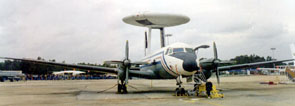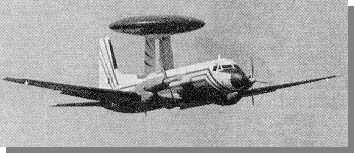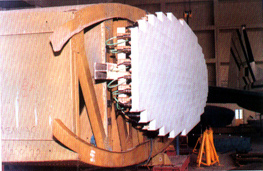FAS |
Military |
DOD 101 |
Systems |
Aircraft |
ROW ||||
Index |
Search |
Join FAS




Airborne Surveillance Platform (ASP)
 The Indian Airborne Surveillance Platform (ASP) is one of the key force multipliers in the modern war scenario. India's Defense Research and Development Organization [DRDO] is developing an advanced surveillance platform based on an HS-748 aircraft to detect targets at extended ranges with all round azimuth coverage. It is designed to handle 50 targets. It features a hybrid navigation system and the secure communication and data links. The DRDO has spent a little over Rs 200 crore to develop this early warning system, similar to the American E-2C Hawkeye. But, o get the capabilities of even the E-2C, India would have to spend at least Rs 2,000 crore. Three HS-748 Avros have been fitted with rotodomes.
The Indian Airborne Surveillance Platform (ASP) is one of the key force multipliers in the modern war scenario. India's Defense Research and Development Organization [DRDO] is developing an advanced surveillance platform based on an HS-748 aircraft to detect targets at extended ranges with all round azimuth coverage. It is designed to handle 50 targets. It features a hybrid navigation system and the secure communication and data links. The DRDO has spent a little over Rs 200 crore to develop this early warning system, similar to the American E-2C Hawkeye. But, o get the capabilities of even the E-2C, India would have to spend at least Rs 2,000 crore. Three HS-748 Avros have been fitted with rotodomes.
Development of the ASP would permit fuller utilisation of the high performance MiG-29, Mirage-2000 and SU-30 planes in the IAF. The utility of ASP also lies in its ability to act as an airborne command and control center, overcoming the limitation of directing air operations from the ground.
The 12 January 1999 crash of the prototype ASP could put India's AWACS program behind by three years, even though developers had completed about 90 per cent of the project. Some reports have blamed DRDO for selecting the 'unreliable' Avro HS-748, but the officials say it was only an experimental platform. The crash, which killed all eight people on board including four scientists, was probably the result of fire or engine failure. Critics questioned whether the aircraft's twin Rolls-Royce Dart turbo-prop engines and metal-fatigued fuselage could withstand the modifications carried out in order to install a rotodome housing a radar on the top with the support of pylons. India does not build aircraft suitable for airborne surveillance; even the Avro was just a test platform. DRDO has contemplated building an operational system around a Russian aircraft, possibly the Il-76. Hindustan Aeronautics had produced 89 aircraft out of which 17 were meant for the Indian Airlines and the balance for the IAF. Though the Indian Airlines had phased out the aircraft in the interest of the passenger safety, the IAF continues to fly it not only as a military freighter but for the VIP duties in the Air Headquarters Communication Squadron. DRDO officials find it hard to believe the eyewitness accounts that the rotodome collapsed on the plane. The indigenous fabrication of the rotodome mounting had won the team the DRDO's'outstanding contribution award' in 1992, and no problem had been reported since.
 Studies and analyses began in July 1985 under project'Guardian', later renamed 'Airawat'. By the late 1980s an Avro had been modified with a 24 ft x 5 ft composite rotodome. The aircraft flew with a pylon (without the dome) in May 1989 and with the rotodome in November 1990. The Centre for Airborne Systems (CABS) was set up in February 1991, under Dr K. Ramchand to act as a system house and integration agency using all the expertise and infrastructure available in India. The project received public recognition when the aircraft was flown during the flight demonstrations at the inauguration ceremony of the first Aero India show held in Bangalore in December 1996. The Defence Research & Development Organisation, Ministry of Defence, provided the airborne surveillance platform to the Navy in August 1998. The program achieved success in most aspects, including airborne radar analysis, clutter (ground reflections) characterisation and measurement and developing a hybrid navigation system. The main challenge left was evolving the radar and support mission system avionics into a flying surveillance platform.
Studies and analyses began in July 1985 under project'Guardian', later renamed 'Airawat'. By the late 1980s an Avro had been modified with a 24 ft x 5 ft composite rotodome. The aircraft flew with a pylon (without the dome) in May 1989 and with the rotodome in November 1990. The Centre for Airborne Systems (CABS) was set up in February 1991, under Dr K. Ramchand to act as a system house and integration agency using all the expertise and infrastructure available in India. The project received public recognition when the aircraft was flown during the flight demonstrations at the inauguration ceremony of the first Aero India show held in Bangalore in December 1996. The Defence Research & Development Organisation, Ministry of Defence, provided the airborne surveillance platform to the Navy in August 1998. The program achieved success in most aspects, including airborne radar analysis, clutter (ground reflections) characterisation and measurement and developing a hybrid navigation system. The main challenge left was evolving the radar and support mission system avionics into a flying surveillance platform.
The antenna used in the rotodome of ASP is a low side lobe slotted wave guide planar array. The antenna features very low side lobe levels and a narrow beam width in azimuth. It handles high power (better than 3.3 KW average) and weighs 160 kg. For housing the primary and the secondary (IFF) antennas, an ellipsoidal structure (7.315 m x 1.524 m) rotodome has been indigenously fabricated. It largely comprises composites and aluminium alloy parts. The indigenous rotodome has since been successfully fabricated and flight tested on the ASP system. The rotodome is driven by a hydraulic servo system using aircraft hydraulic power.
The airborne radar data processor (ARDP), supporting track-while-scan, is required to form target tracks after receiving data from the various sensors of ASP, such as the primary radar (PR) and the secondary surveillance radar (SSR), which operate in TWS mode. The ARDP correlates the target plots from scan to scan to maintain the target tracks. It also performs the correlation of target information obtained from SSR and endorsement with the PR track information.
The ASP is guided by a high accuracy navigation system, which consists of an inertial navigation system (INS) and a Doppler navigation system. The velocity drifts of INS are contained by Doppler velocities using a Kalman filter, resulting in good navigation accuracy required for long duration flight of ASP. Work is in hand to integrate GPS receiver with INS to enhance performance, reliability and robustness.


Sources and Resources
FAS |
Military |
DOD 101 |
Systems |
Aircraft |
ROW ||||
Index |
Search |
Join FAS
http://www.fas.org/man/dod-101/sys/ac/row/asp.htm
Maintained by Robert Sherman
Originally created by John Pike
Updated Monday, August 09, 1999 12:36:50 PM